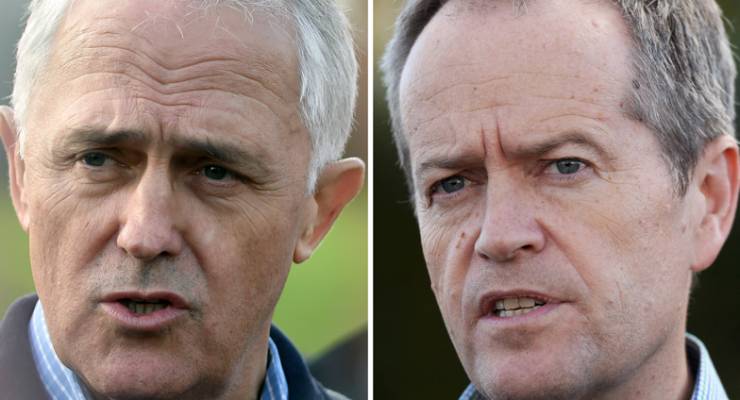
Between the closure of nominations on Friday and today’s commencement of early voting, the increasingly bitter game of pre-election preference trading has finally come to a head.
What seems to be emerging is the outline of a grand bargain between Liberal and Labor, in which each lends support to the other in their increasingly fraught endeavours to stave off minor party predators.
Until quite recently, the routine practice of both major parties was to place the other last on their how-to-vote cards, reflecting a view of politics as a zero-sum game involving only two contestants worthy of the name.
A turning point arrived in 1998, when Labor saw the rise of Pauline Hanson’s One Nation as an opportunity to lay down a gauntlet to John Howard, who remained encumbered by the legacy of his assertion a decade earlier that the rate of Asian immigration should be slowed.
The Liberals’ habit of putting the Greens last is even more recently acquired, having only really caught on after it proved a match-winner at the Victorian state election in November 2010 — little more than three months after the party’s preferences had elected Adam Bandt to the federal seat of Melbourne.
Both proved effective as wedge tactics against the opposing major party, most spectacularly with respect to One Nation preferences in Queensland, which caused the Coalition parties to all but disintegrate there at state level.
This time though, the extent of the major parties’ mutual preference dealing could end up feeling more like collusion than competition.
Labor should be feeling particularly grateful towards its old enemy for the good turn it has been done in inner Melbourne, in defiance of the recent assertion by the Liberal Party’s influential state president, Michael Kroger, that Richard Di Natale was a Greens leader the Liberals could do business with.
In decreeing otherwise, Malcolm Turnbull would have been mindful of the two great weaknesses in the Greens’ negotiating hand: the effective limitation of their options to favouring Labor or running an open ticket, since an active preference to the Liberals would be beyond the pale for most of the party’s supporters; and the fact that less than a quarter of Greens voters follow their party’s how-to-vote card.
At most, the Greens could promise to deliver about half a percentage point to the Liberals’ final two-party preferred total in its Victorian marginals of La Trobe, Deakin and Corangamite, which became ever less tempting as the Liberals grew increasingly confident that would retain these seats in any case.
Conversely, a Liberal direction to preference Labor last stood to transform the Greens’ share of their preferences from one-third to at least three-quarters, if the contrasting experience of the Melbourne electorate in 2010 and 2013 is any guide.
That alone would have wiped out Labor MP David Feeney’s 10.6% margin over the Greens in Batman, while leaving uncomfortably little of Labor’s 15.2% margin intact in neighbouring Wills.
For its part, Labor is directing preferences to the Liberals ahead of the Nationals in three-cornered contests in the northern Victorian seat of Murray, and the regional Western Australian seats of Durack and O’Connor.
Murray is the most consequential of the three, as the Liberals are straining to defend the seat from state Nationals MP Damian Drum after their retirement of the Liberal member of 20 years, Sharman Stone.
Labor is worth about 20% of the primary vote in Murray, about a quarter of which appears to follow the how-to-vote card.
Taken in isolation, there is nothing extraordinary about the Liberals putting the Greens last or Labor favouring Liberal in three-cornered contests, just as they both did in 2013.
But in South Australia, a mutual desire to clip Nick Xenophon’s wings could yet take the major parties where no preference deal has gone before.
Labor has threatened to run open tickets in the state unless Xenophon comes to the preference negotiation table, which hardly seems likely given his long-established and highly successful practice of keeping equal distance from both major parties.
Xenophon is clearly expecting something similar from the Liberals, to the extent that he has raised the threat of retaliating by directing preferences against all sitting members, as One Nation did to great disruptive effect at the Western Australian state election in 2001.
From a narrow electoral perspective, the impact of major party open tickets should not be overstated. Left to their own devices, the great majority of Labor and Liberal voters will continue to favour Nick Xenophon Team candidates over those of the rival major party, with or without the direction of a how-to-vote card.
The greater significance of Malcolm Turnbull’s “captain’s call” on preferences lies in its attempt to tar Labor with the brush of minority government, something Labor will be stuck with to some extent for as long as its primary vote remains stuck in the mid-thirties.
Labor’s readiness to offer the Liberals something in return has more to do with sidestepping Turnbull’s trap than with protecting David Feeney, who has been left to explain to his constituents what those billboards denouncing a Liberal-Greens preference deal were all about.
The next big question is whether the cosiness of Liberal-Labor arrangements causes yet more voters to turn away from them both, thereby intensifying the very pressures that brought the arrangements about in the first place.
*To read more from Crikey‘s William Bowe, visit The Poll Bludger








William, your last sentence is the crux. My own admittedly very unscientific sense of the electorate is that a growing percentage of people are heartily sick of the cosy arrangements the duopoly make when their privileged poison is threatened. Turnbull’s ‘captain’s call’ is very likely to come back and bite him in the proverbial.
I certainly hope you are correct but it appears unwise to overestimate the intelligence of the voters
How smart you are Swen ,,,,,,,,,, what a supercilious twat you are!!!!
“it appears unwise to overestimate the intelligence of the voters” all those other than thou.
Is this so surprising? The Queensland Labor government has just summarily got rid of Optional Preferential Voting. The distaste for the Greens by the ALP is palpable. Talk about biting the hand that feeds you!
What ensuring voters get the maximum benefit from their ballot has to do with distaste for the Greens I am struggling to comprehend. OPV was a cynical Beattie era device to decouple the combined Lib/Nat preference effect. As Labor learnt in 2015 the call to number every box and put the LNP last was an effective strategy to destroy a huge majority
Bill, if you are genuinely confused by the effect of OPV removal on our voting options, read the Anthony Green article on this matter:
http://blogs.abc.net.au/antonygreen/2016/04/electoral-law-ructions-in-the-queensland-parliament.html
“The rise of the Greens, and the weakness of Green preference flows to Labor under OPV compared to full preferential voting, has clearly driven this move by the Labor government.”
“Since OPV was introduced, the highest rate of informal voting at a state election was 2.3%. It is now consistently above 5% in Queensland at federal elections under full preferential voting.”
My hope is the new Senate has an unprecedented number of independents, thus proving the electorate won’t be backed into a corner by the major parties.
It’s cartel politics from start to finish. Very bad sign for democracy that Labor and Liberal would rather protect each other’s jobs than risk an outsider gaining a foothold.
Many Liberal voters will still put The Greens ahead of Labor despite the so-called captain’s call. What a stupid piece of strategy , that captains call. Wouldn’t the Liberals be better off sitting back seeing what long-term damage can be done by the Greens pressuring Labor in inner-city seats? No? They actually prefer a duopoly?